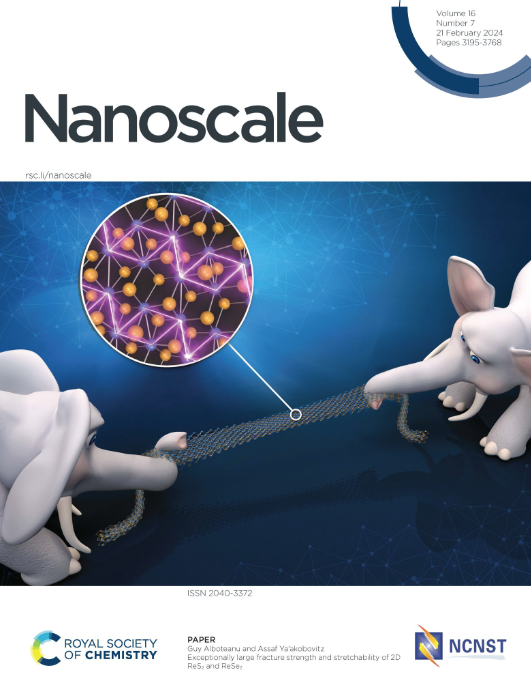Molecular additive-driven control of Cu/Cu₂O nanoparticle growth on mesoporous silica for enhanced photocatalytic hydrogen production
IF 5.8
3区 材料科学
Q1 CHEMISTRY, MULTIDISCIPLINARY
引用次数: 0
Abstract
Size-controlled cuprous oxide-based nanoparticles (NPs) are promising materials for enhancing visible-light-driven photocatalytic hydrogen production by increasing the number of Cu+ surface-active sites. This study investigates the role of molecular additives in the growth of Cu/Cu₂O NPs on mesoporous silica (m-SiO2) templates. The molecular additives, cetyltrimethylammonium bromide (CTAB), ascorbic acid (AA), and citric acid (CA) are analyzed for their ability to modify the zeta potential of m-SiO₂, facilitating the adsorption of Cu⁺ ions. The modified surface effectively controlled the interaction between Cu⁺ ions and the m-SiO₂ surface through the influence of molecular additives. The CTAB system facilitates a rapid nanoparticle (NP) growth rate and significant aggregation, thereby promoting Cu⁺ ion adsorption and subsequent larger NP formation. In contrast, CA provides better control over NPs formation, preventing aggregation through Cu²⁺ chelation and stabilizing it on the mesoporous voids of silica. Furthermore, the intensity ratio of metallic Cu to Cu₂O is the lowest value of 0.47 in the CA system, indicating a higher Cu₂O content compared to CTAB and AA systems. It was observed that the CTAB and AA systems are more favorable for the formation of metallic Cu in the NPs. As a result, the CA system achieves a 5-fold increase in hydrogen production rate under visible light compared to the CTAB system. These findings highlight the critical role of molecular additives in tailoring NPs growth and photocatalytic performance.分子添加剂驱动的Cu/Cu₂O纳米颗粒在介孔二氧化硅上生长以增强光催化制氢
尺寸可控的氧化亚铜纳米颗粒(NPs)是一种很有前途的材料,可以通过增加Cu+表面活性位点的数量来增强可见光驱动光催化制氢。本文研究了分子添加剂在介孔二氧化硅(m-SiO2)模板上Cu/Cu₂O NPs生长中的作用。分析了十六烷基三甲基溴化铵(CTAB)、抗坏血酸(AA)和柠檬酸(CA)这三种分子添加剂对m- sio2的zeta电位的修饰能力,从而促进了Cu⁺的吸附。改性后的表面通过分子添加剂的影响,有效地控制了Cu +离子与m-SiO₂表面的相互作用。CTAB系统促进了纳米颗粒(NP)的快速生长和显著聚集,从而促进Cu +离子吸附和随后更大的NP形成。相比之下,CA可以更好地控制NPs的形成,通过Cu 2 +螯合防止NPs聚集,并将其稳定在二氧化硅介孔空隙上。此外,金属Cu与Cu₂O的强度比在CA体系中最低,为0.47,表明与CTAB和AA体系相比,Cu₂O含量更高。结果表明,CTAB和AA体系更有利于NPs中金属Cu的形成。因此,与CTAB系统相比,CA系统在可见光下的产氢率提高了5倍。这些发现强调了分子添加剂在调整NPs生长和光催化性能方面的关键作用。
本文章由计算机程序翻译,如有差异,请以英文原文为准。
求助全文
约1分钟内获得全文
求助全文
来源期刊

Nanoscale
CHEMISTRY, MULTIDISCIPLINARY-NANOSCIENCE & NANOTECHNOLOGY
CiteScore
12.10
自引率
3.00%
发文量
1628
审稿时长
1.6 months
期刊介绍:
Nanoscale is a high-impact international journal, publishing high-quality research across nanoscience and nanotechnology. Nanoscale publishes a full mix of research articles on experimental and theoretical work, including reviews, communications, and full papers.Highly interdisciplinary, this journal appeals to scientists, researchers and professionals interested in nanoscience and nanotechnology, quantum materials and quantum technology, including the areas of physics, chemistry, biology, medicine, materials, energy/environment, information technology, detection science, healthcare and drug discovery, and electronics.
 求助内容:
求助内容: 应助结果提醒方式:
应助结果提醒方式:


